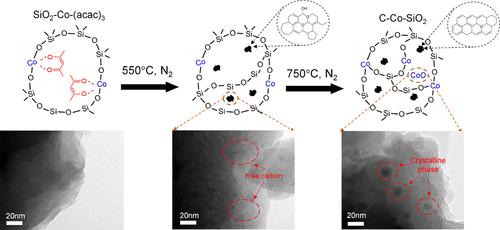当前位置:
X-MOL 学术
›
ACS Appl. Mater. Interfaces
›
论文详情
Our official English website, www.x-mol.net, welcomes your
feedback! (Note: you will need to create a separate account there.)
Design of Silica-Cobalt Composite Microporous Structures with Dispersed Carbon Particles for Highly Permselective Gas Separation Membranes
ACS Applied Materials & Interfaces ( IF 8.3 ) Pub Date : 2024-11-18 , DOI: 10.1021/acsami.4c15378 Kento Soma, Norihiro Moriyama, Hiroki Nagasawa, Toshinori Tsuru, Masakoto Kanezashi
ACS Applied Materials & Interfaces ( IF 8.3 ) Pub Date : 2024-11-18 , DOI: 10.1021/acsami.4c15378 Kento Soma, Norihiro Moriyama, Hiroki Nagasawa, Toshinori Tsuru, Masakoto Kanezashi

|
Metal-doped silica membranes, fabricated via the sol–gel technique using metal nitrates, hold promise for high-temperature separation processes, such as H2 separation in steam reforming reactions. However, controlling the status of the doped metal is challenging and often leads to defect formation owing to the aggregation of metal oxides. In this study, we designed a uniform carbon–Co–SiO2 ceramic membrane using a one-pot sol–gel method with copolymerization, employing tetraethoxysilane and cobalt acetylacetone(III) (Co-(acac)3) as precursors. Organic chelate ligands within the amorphous silica network formed by the polymerization reaction were carbonized by calcination at 250–750 °C in an inert atmosphere. This approach suppressed defect formation and tailored the microporous structures to a wide range of separation systems. For example, the SiO2–Co-(acac)3 membrane calcined at 550 °C demonstrated a notable C3H6 permeance of 4.0 × 10–8 mol m–2 s–1 Pa–1 (GPU: 120), with a high C3H6/C3H8 selectivity of 46, attributed to the molecular sieving effect, whereas the membrane calcined at 650 °C exhibited a remarkable He permeance of 4.6 × 10–7 mol m–2 s–1 Pa–1 (GPU: 1400), with a high He/CH4 selectivity of 830. This study provides valuable insights into the development of defect-free carbon–cation–SiO2 ceramic membranes for a broad range of gas separation processes.
中文翻译:

用于高选择性气体分离膜的分散碳颗粒硅钴复合微孔结构设计
使用金属硝酸盐通过溶胶-凝胶技术制造的金属掺杂二氧化硅膜有望用于高温分离过程,例如蒸汽重整反应中的 H2 分离。然而,控制掺杂金属的状态具有挑战性,并且由于金属氧化物的聚集,通常会导致缺陷的形成。在这项研究中,我们使用共聚的一锅溶胶-凝胶法设计了一种均匀的碳-Co-SiO2 陶瓷膜,采用四乙氧基硅烷和钴乙酰丙酮 (III) (Co-(acac)3) 作为前驱体。聚合反应形成的无定形二氧化硅网络内的有机螯合物配体在惰性气氛中于 250–750 °C 通过煅烧碳化。这种方法抑制了缺陷的形成,并为各种分离系统定制了微孔结构。例如,在 550 °C 下煅烧的 SiO2–Co-(acac)3 膜表现出 4.0 × 10–8 mol m–2 s–1 Pa–1 的显著 C3H6 渗透率(GPU:120),由于分子筛分效应,C3H6/C3H8 选择性高达 46,而在 650 °C 下煅烧的膜表现出 4.6 × 10–7 mol m–2 s–1 的显著 He 渗透率Pa–1 (GPU: 1400),He/CH4 选择性高达 830。本研究为开发用于各种气体分离工艺的无缺陷碳-阳离子-SiO2 陶瓷膜提供了有价值的见解。
更新日期:2024-11-19
中文翻译:

用于高选择性气体分离膜的分散碳颗粒硅钴复合微孔结构设计
使用金属硝酸盐通过溶胶-凝胶技术制造的金属掺杂二氧化硅膜有望用于高温分离过程,例如蒸汽重整反应中的 H2 分离。然而,控制掺杂金属的状态具有挑战性,并且由于金属氧化物的聚集,通常会导致缺陷的形成。在这项研究中,我们使用共聚的一锅溶胶-凝胶法设计了一种均匀的碳-Co-SiO2 陶瓷膜,采用四乙氧基硅烷和钴乙酰丙酮 (III) (Co-(acac)3) 作为前驱体。聚合反应形成的无定形二氧化硅网络内的有机螯合物配体在惰性气氛中于 250–750 °C 通过煅烧碳化。这种方法抑制了缺陷的形成,并为各种分离系统定制了微孔结构。例如,在 550 °C 下煅烧的 SiO2–Co-(acac)3 膜表现出 4.0 × 10–8 mol m–2 s–1 Pa–1 的显著 C3H6 渗透率(GPU:120),由于分子筛分效应,C3H6/C3H8 选择性高达 46,而在 650 °C 下煅烧的膜表现出 4.6 × 10–7 mol m–2 s–1 的显著 He 渗透率Pa–1 (GPU: 1400),He/CH4 选择性高达 830。本研究为开发用于各种气体分离工艺的无缺陷碳-阳离子-SiO2 陶瓷膜提供了有价值的见解。


















































 京公网安备 11010802027423号
京公网安备 11010802027423号